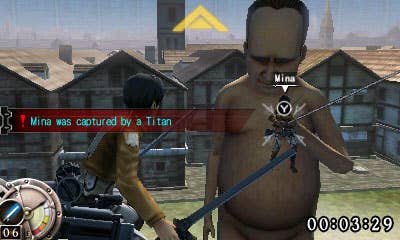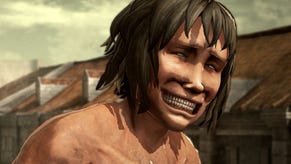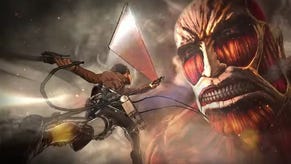Attack on Titan: Humanity in Chains 3DS Review: The Harder They Fall
Spike Chunsoft's all-too-literal adaptation fails to make anything worthwhile out of the source material's irresistibly great premise.
This article first appeared on USgamer, a partner publication of VG247. Some content, such as this article, has been migrated to VG247 for posterity after USgamer's closure - but it has not been edited or further vetted by the VG247 team.
Given the state of the anime industry these days, it's been no surprise to see Attack on Titan take off the way it has. It daringly casts off popular, pandering trends in exchange for a fairly somber story with high stakes and great action scenes--especially for TV animation.
Even though I eventually stopped watching Attack thanks to some particularly odd and meandering decisions made halfway through its first season, the series' premise, at least, still strikes me as an amazing idea for a Shadow of the Colossus-style video game. In a nutshell, Attack pits an army of humble humans against massive, naked, giants who seek only to devour their tiny prey. The humans have one advantage at their disposal, though: A steam-powered grappling system that lets its users zip effortlessly through the air like Spider-Men and Women. (An especially important tool, since the titans can only be brought down by slashing open the napes of their necks.)

Spike Chunsoft's interpretation of the source material plays out in an extremely literal fashion. Humanity in Chains essentially follows the story of the anime, beat-by-beat, spread across a handful of characters with their own unique missions. If there's an action scene in the anime series, it's most likely replicated here, with a cut scene (ripped right from the show) or text provided to give it some context. But not too much context; you'll definitely need to have seen the show to understand the significance of what's going on.
To its credit, Spike Chunsoft does a pretty good job of replicating the action from Titan's anime. Obviously, the meticulously crafted choreography and camera angles from the animated series couldn't possibly have made the cut, but Humanity in Chains still manages to convey the versatility of the characters' steam-powered gear. And the Titans themselves don't actually take too much effort to fell. Humanity in Chains' battles focus on targeting certain body parts to attack, but you'll never need to lock onto anything but an ankle and the nape of the neck: Once you drop a titan to its knees, it's incredibly easy to slash away at its most vulnerable spot.
It might take an hour-or-so to click, but once you wrap your mind around Attack on Titan's control scheme, bouncing from giant to giant without touching the ground can feel pretty empowering. The biggest problem, though, is that you only need to play a few missions to see everything Humanity in Chains has to offer. Though the missions may drop you into different settings, your essential actions never change throughout, so it doesn't take very long for the doldrums of repetition to set in.

But whenever Humanity in Chains tries to make its objectives more complex than "kill everything," things can get downright painful. Missions that task you with protecting something grow frustrating fast, since the lock-on system and the camera don't know what to do when a handful of titans are clumped together on the map. The few times Attack on Titan tries to deviate from its formula for the sake of deviation feel completely undercooked, too. Fighting as one of the titular monsters feels almost on par with Rock 'Em Sock 'Em Robots' level of complexity, while other missions simply have you running circles through checkpoints as dangers linger far behind. And if you enjoy scouring large, barren environments for a prescribed number of resources--represented by barely visible glowing balls--that's here, too! (Lucky you.)
"World Mode," which divorces itself from Humanity in Chains' literal anime adaptation, feels like the beginning of a better game. The action from the core campaign hasn't changed, but World Mode lets you use your own custom character, and missions now pay out money and experience points instead of simply unlocking new missions. There's some new traps and healing items to try out in this optional mode, too, but these new hooks do little to improve the experience that serves as their foundation. If you managed to finish off Story Mode--and struggle through the latter sections, where everyone's missions seem to overlap--the light RPG trappings in World Mode really don't make for a great incentive to jump back in.
With Humanity in Chains resting solely on the power of its brand, I honestly wasn't expecting much from Spike Chunsoft--though the untapped potential here still managed to disappoint. As a fan of some of their other works like Danganronpa, I honestly don't think Spike has the specialized talent or healthy budget to make a satisfying action game out of Attack on Titan, which is why it's been a shame to see their efforts fail so spectacularly here. And really, Humanity in Chains doesn't even have that oh-so-important fan appeal; if you've seen the show, this is essentially an adulterated version of that experience. Should Attack on Titan last long enough for another developer to get its hands on the license, we may see a proper adaptation of the series' legitimately great action one day. Until then, this isn't it.
InterfaceHumanity in Chains' simple control scheme works well, and can feel downright empowering as you're zipping through the air. Just don't expect the camera to always cooperate.
Lasting AppealWorld Mode offers plenty of stuff to do once the 10-hour Story Mode reaches its conclusion, but does little to alleviate the repetition that serves as Humanity in Chains' foundation.
SoundMostly unnoticeable, though that means nothing stands out as particularly annoying.
VisualsEven though the titans drop frames of animation to a distracting degree when they're in the distance, Humanity in Chains does a fairly good job of depicting the events of the anime.
ConclusionAttack on Titan contains the premise for an amazing video game, but never delivers on this potential. With their overly literal interpretation of the source material, Spike Chunsoft really limited what they could do with their adaptation, leading to an incredible amount of repetition. If you enjoy the series, your time would be better spent just watching it all over again.






